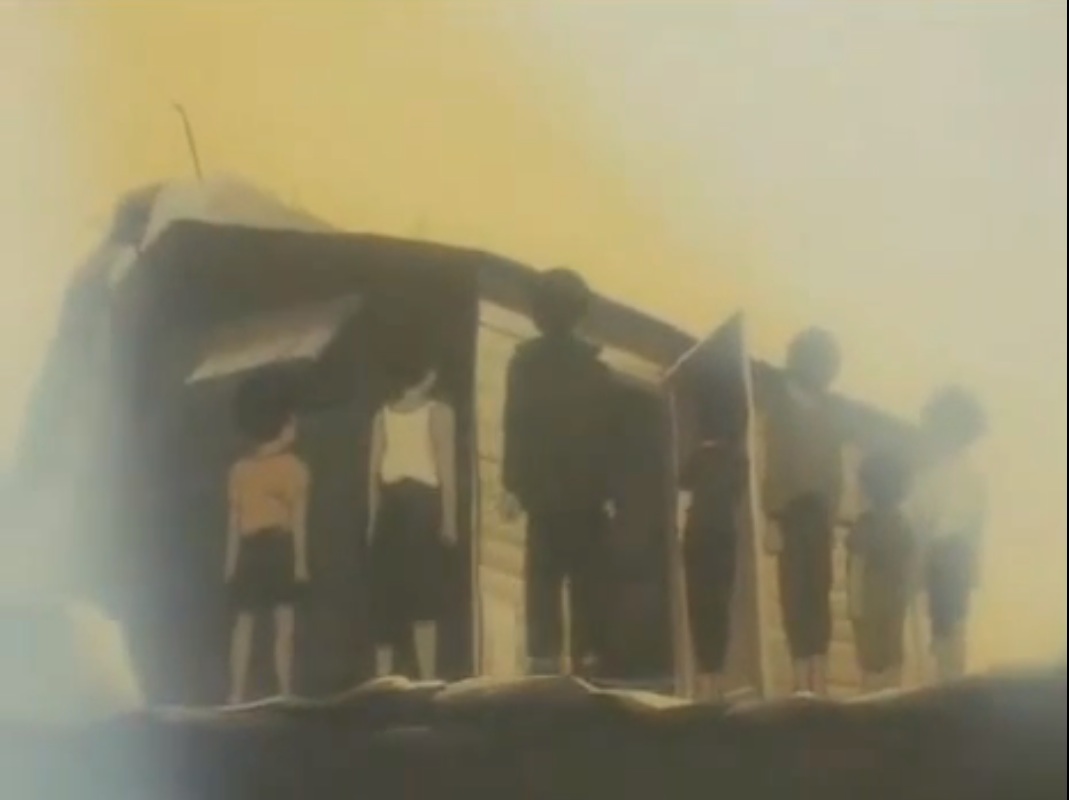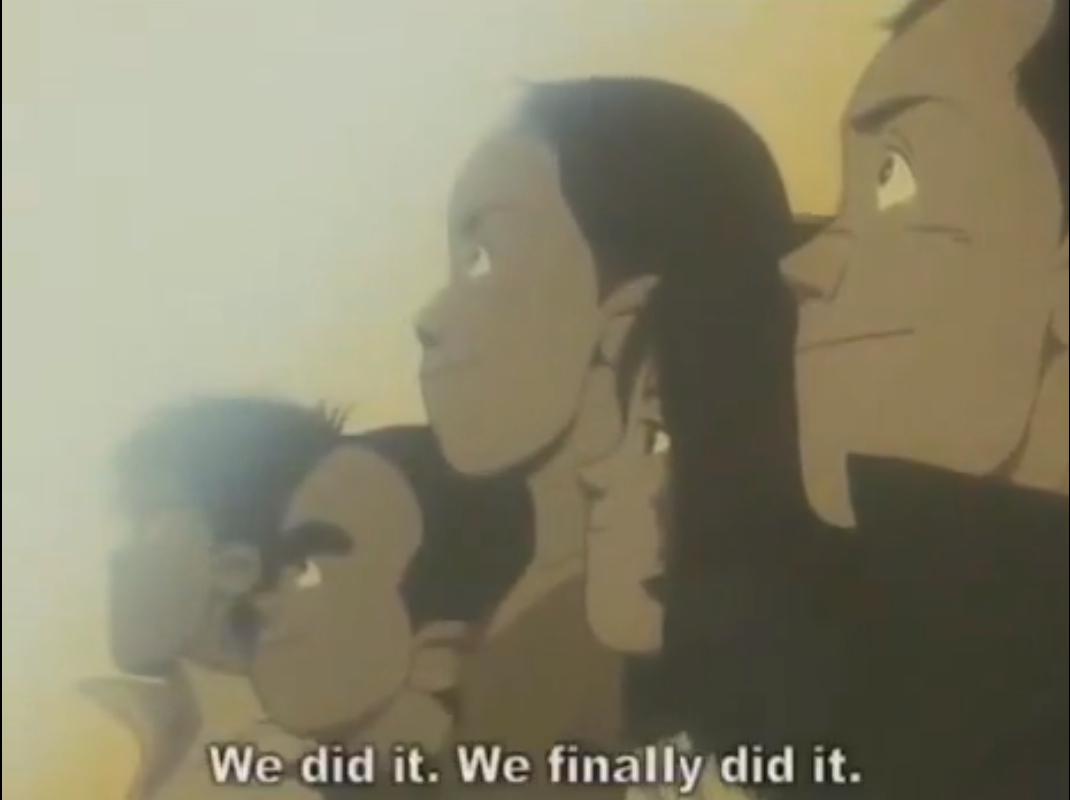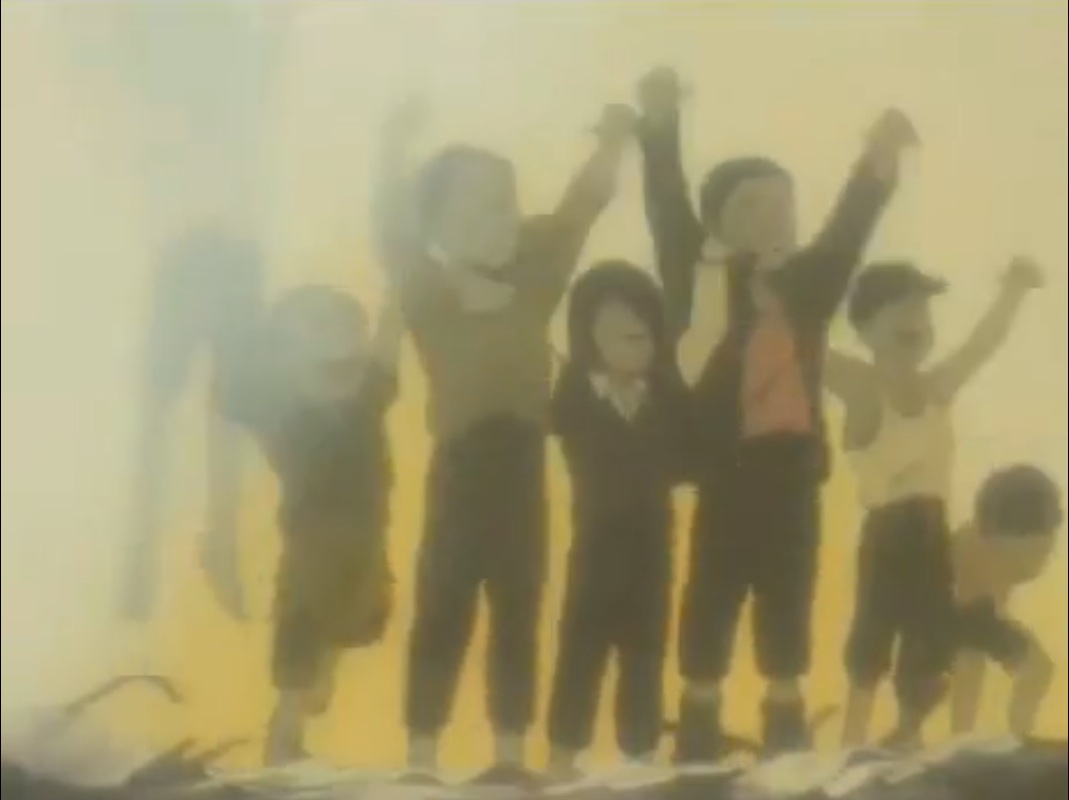An essay on
Barefoot Gen 2
Xue Jin, Bryn Mawr College, Class of 2015
Barefoot Gen 2, an animated film produced by Hirata Toshio in 1986, is a sequel of Barefoot Gen, which has generated tremendous influence on disaster representation by focusing on the expressive depiction of the atomic bombing of Hiroshima in 1945. Both of the films are adaptations of the manga series Barefoot Gen (Hadashi no Gen) started in 1973 and concluded in 1985 by Nakazawa Keiji based on his real experience (Hongo, 2013).
Barefoot Gen 2 tells stories of lives of ordinary people – especially orphans – three years after the atomic disaster: what they had been continuously suffering from and how they managed to survive and recover. With a nine-year-old boy Nakaoka Gen as its hero, the film highlights not only physical but also mental reconstruction. It shows how orphans helped each other out by regrouping as a family; how Gen fought against the disease caused by radiation and rumors on its infectivity by taking care of his mother and friends; how children struggled between the moral fault of stealing and the lack of money; how people tried to recollect courage from memories of their times with now dead family members, etc.
Not only does its content focus on reconstruction, the film itself is also a means of emotional support. Converting personal stories into manga was the way by which Nakazawa reflected on and recovered from the disaster, and that the manga was later adapted into various media forms – films, animated films, live shows, TV series, books, musicals, etc. (Hongo, 2013) – makes it into a vehicle for its Japanese audience to share the similar process of mental reconstruction collectively.
Example Scene: The Construction of A New House by the Orphans
Once antagonistic to but later becoming friends with Gen and Ryūta, the gang of orphaned children led by Brother Masa lost their temporary shelter after a typhoon. Gen joined the group and encouraged the others to build a house for themselves with the remaining materials available. The orphans, along with an old man with no family, lived in the house together ever since, and Gen and Ryūta also regarded it as a base, which perhaps turned into their home as well after the death of Gen's mother.
00:44:00~00:46:15 When the rain flooded the shelter in which the orphans used to live, Gen, Ryūta, and the orphans decided to build their own house.
Analysis of Example Scene
The film focuses on Hiroshima people's long struggle and attempts to go back to normal life after the atomic bombing, and one interesting example it brings up is how mutual support took place in the form of people regrouping as families. The theme is actually not unique in the example selected; in Barefoot Gen, Gen and his mother adopted Ryūta, who looked much like Gen's dead brother, as their family member. As for Barefoot Gen 2, the problem of orphaned children was heavily stressed, and the theme of regrouping family occurs again. The scene of Gen, Ryūta and the gang of orphaned children erecting their new house is significant because it carries multiple layers of meanings.
The construction of new house is in its nature a process of reconstruction. The very fact that the building materials were from disaster rubble and the building site was within an abandoned neighborhood corresponds with the larger picture in Hiroshima – given the struggling situation all over Japan, Hiroshima could rarely rely on outside support; it needed to be reborn from its own ashes. On the other hand, as to the orphans, although they had a shelter in a ruined building before, it wasn't until the construction of the new house that they stopped worrying about being put into an orphanage. The house seemed to possess a sense of recovery, independence and new identity; it also tied the children together and regrouped them as a family.
Such spirits of humanity and hope are also reflected in the technical elements of the film. The section of the construction process is one of the few parts where bright and vivacious music was used; the lively conversation among children also contributes to the vigor and cheerfulness the scenes carry. Visually, the scenes capture the audience's attention with an audacious use of yellow, creating a dreamlike atmosphere, which is also very unique, almost iconic, in such a relatively realistic animation. Here the filmmaker fully took advantage of the medium of animated film – the expressiveness of color and sound was not achievable in any form of live-action media, not to mention the original work of manga.
The subject matter in the example – orphans – is also worthy of examination. For one thing, Nakazawa has a special understanding on and consideration for orphans, and his portrayal of their story conveys his good wish of inclusiveness among the victims. Nakazawa once described his own experience after moving to Eba, Hiroshima with his family. There he was bullied by local urchins because he was an "outsider"; he notes that, "I feel I saw real human nature - rejecting the outsider. Helping each other - that's an illusion" (Nakazawa, 2007). However, Barefoot Gen 2 exemplifies the formation of an unusual form of intimate relationship after the disaster. Bridging Nakazawa's real experience with the fictional work he created, the contrast expresses that the aloofness in reality sets off the preciousness of mutual support shown in Barefoot Gen 2.
Furthermore, the image of the orphan may represent Nakazawa's view of Japan at that time. As he constantly mentioned, he "absolutely [could not] tolerate the Imperial system", which is expressed in his writing as "a fearsome anger toward power, toward rulers"; he even advocated people to "question its existence" (Hongo, 2013). Earlier in the film, Brother Masa mentioned that they escaped from the orphanage because people there "[forced] rules upon [them]" while they "[wanted] to enjoy [their] lives freely without anybody's control" (Hirata, 1986). Thus, it is reasonable to argue that the orphans stand for Nakazawa's expectation of a new Japan escaping the shadow of the emperor system. Similarly, the action of them regrouping as a family and building up a house for themselves may carry a broader political meaning of independence.
Conclusion
In the construction of the new house and regrouping of family function as an icon for physical reconstruction and mental recovery, and further by comparing the depiction in the film to Nakazawa's recollection on actual situations, the audiences may see a tension between illusory expectation and cruel reality, and the author's own wishes for Japan. Barefoot Gen has been regarded as "a haunting reminder of the suffering that war brings to innocent people" ("Barefoot Gen Collection," n.d.). Specifically in the animated film Barefoot Gen 2, by telling stories about how orphans struggled to survive, supported each other, and regained confidence to live after trauma, the filmmaker reflects the way its original creator rebuilt mental strength for himself after the disaster, and further brings its audience a collective means of mental recovery, as one may glimpse through the example discussed above.


